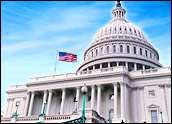
Dean Kamen, inventor of the Segway, and Steve Perlman, who developed Apple’s QuickTime video technology and WebTV, were among the people who descended upon Capitol Hill to protest the Patent Reform Act passed by the House of Representatives at the beginning of September.
Kamen and Perlman are perhaps two of the more iconic representatives of a group called the Innovation Alliance, which also includes members of almost every patent-dependent sector in the economy — except high tech, which is strongly supporting the Act.
Critics of the bill, which has the support of such companies as Microsoft, Apple, Cisco, Google, eBay, Intel, Hewlett-Packard, Amazon.com and Oracle, say it will devalue the patent process, rob small companies and single inventors of their work and leave the United States open to IP theft from foreign-based competitors.
To be sure, some of these arguments are designed more for emotive appeal than what actually occurs in the Byzantine-like U.S. patent system.
Some points raised by critics, though, do have validity — as well as a certain sense of inevitability. That is because the changes proposed in the Act radically realign the balance of power in how patents are granted and challenged.
In short, someone was bound to protest.
Three Major Changes
When the House passed the Act in the first week of September, many were surprised at the depth of the changes that made it into the House version. The three biggest alterations were a switch to a first-to-file system from the current first-to-invent, new metrics to calculate damages for infringement, and new procedures to protest a filing at the Patent & Trademark Office (PTO).
The switch to first-to-file was perhaps the most dramatic — it represents a 180-degree change philosophically for the U.S. patent system. As the name suggests, first-to-file means that a patent is awarded to anyone who files for it first at the PTO — regardless of whether or not he or she is actually the first to invent the innovation.
The change has been criticized, given America’s general admiration of individual ingenuity. However, the entire world save for the United States follows first-to-file in their patent laws. Shifting to it would bring the United States in line with norms established by the rest of the world.
The image of the new patent laws allowing a big-bucks corporation to get away with stealing a small but plucky inventor’s creation is a myth designed more to enrage than educate, Pillsbury IP partner Bryan Collins tells the E-Commerce Times. “The number of US patents that this change would impact is so small that it is difficult to measure,” he said. “In many ways, this is a straw man issue.”
Small companies, though, do have a legitimate grievance with a first-to-file system given the expense associated with filing for a patent, which can range from US$5,000 to $25,000. “A company could be working on several ideas at once but only afford to patent one or two,” Berliner said.
The Act does provide some leeway for these firms that would otherwise be forced to choose which ideas to patent while at the whiteboard stage. It provides a window for use prior to filing for patents and other protections against theft.
Part of the Whole
The part of the Act that would have the greatest impact on the way patent infringement is litigated is a measure that allows courts to consider portions of a product — as opposed to the entire product — when awarding damages. The tech industry, in particular, is very protective of this clause, for which it heavily lobbied.
“Let’s say you invented a piece of software that supported spell checker in Microsoft Office for which you didn’t receive a license,” Collins said. “If you sued for infringement and won, the judge now has greater latitude in determining the damages.” The judge, for instance, could accept an argument that while the piece of software only costs $1 per the $50 product, the spellchecker has been heavily advertised and is a leading driver of sales and therefore deserves more in damages. The Act would limit such damages.
Streamlining Invalidation
The Act also makes it easier to invalidate a patent, said Gwendolyn R. Acker Wood, a partner with Eckert Seamans Cherin & Mellott.
“Now a defendant in a patent suit has to go to court, pay all kinds of fees, and because it is usually federal court it gets to be very expensive,” she told the E-Commerce Times. “Part of the defense is to try to invalidate the patent. No patent — no infringement.”
The new rules allow anyone to go directly to the PTO and file an opposition in which they allege the patent is invalid.
Big Change
It’s impossible to know whether this Act will eventually become law, at least in this form, Brian Berliner, a partner in O’Melveny & Myers LLP, told the E-Commerce Times.
“There is a lot of support for the changes in some industries,” he said. Also, the Bush Administration is supportive of a lot of it.”
Whether that is enough to overcome the strident opposition against the Act remains to be seen.























































Social Media
See all Social Media